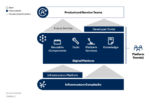There was a time when dev was development and ops was IT operations. But like the famous Reese’s Peanut Butter Cup advertising, someone got dev in their ops team. Or did they get ops in their dev team? Whichever way the pendulum swings, the devops movement—if it is a movement—is about breaking down the walls between the people who write software and the people who have to keep it running.
That’s because traditional IT operations focused on information running within the organization, such as desktops or servers in the data centers. While IT operations naturally expanded to cover servers deployed in remote data centers, such as hosting facilities, applications running in the cloud appear to be defying that traditional role. And thus managers are hiring devops: developer operations specialists within the development department itself.
Devops was the big trend for 2010, with job-search site Indeed recording an increase in the term “Devops” in available job postings. While the term is still far behind mainstay development words like “Java,” “C” and even “Ruby” in job ads, the growth of the term was far beyond the growth rate of any other development term across the year.
Andrew Phillips, vice president of product development at XebiaLabs, which sells an automated Java application deployment system, believes that the devops role is a genuine movement, not merely a new name for an old job. “A movement is always a big term. I think when agile started it wasn’t a movement, but now it’s become in fashion,” he said.
“I think we’ll see a similar development with devops. It’s just a mindset that realizes you can’t split development and operations in your organization and still expect quick turnaround release cycles.”
Inspiration and revelation
Mike Maciag, CEO of Electric Cloud, which sells build and continuous integration tools, said that devops comes from the ever-rising popularity of agile. “We’re seeing customers bridge that devops gap. Some of that is driven by agile,” he said.
“If you’re talking about agile, it’s how fast can I turn that crank? I need a lot of machines, so I need to work with IT. Virtualization is helping people solve that problem.”
Maciag believes that devops is definitely a new trend, and one that is spreading rapidly. “Two years ago, we didn’t actually see devops. I would say now, in 50% of our customers, we see devops. Devops is much more prevalent in the customer base and in the enterprise IT shops. I’m not yet seeing devops in embedded software companies, ISVs and the likes. You are seeing devops in healthcare, retail and insurance.”
But Mike Gualtieri, senior analyst with Forrester Research, said that virtualization and cloud computing will eventually be the undoing of this movement.
“I think it’s a real movement. I think it’s going to have a short life, mostly because of cloud computing and virtualization,” he said. “When you start to think about architectures of the future, it’s going to be not about having virtual servers in the cloud. There’s no one to talk to in the cloud. You’re not going to have ask IT to come down with an ops guy in the cloud. You’re going to architect your applications to scale on whatever cloud infrastructure is available.”
Gualtieri said that because cloud development is in its infancy, most developers and clouds are not yet ready for the next model of deployment: bare-metal applications without regard for the hardware underneath. In a cloud, he said, the hardware is essentially irrelevant, meaning anyone working in devops in the cloud is basically living on borrowed time as the servers themselves become less and less relevant.
“I don’t think ops guys actually understand the hardware very much,” said Gualtieri. “I think they understand how to operate it, but if you go to an enterprise IT shop and talk to an ops guy, they typically over-buy hardware because they have no idea how much resources the software really uses.
“You always hear about the CPU usage at 15%, and that’s how virtualization got big. Now they’re just allocating virtual machines, and that VM is the 15% utilization. Cloud will eventually change that, but we’re not there yet.”
Gualtieri added that one of the reasons for the devops movement is that “usually, when I talk to an ops guy, what he tells me is ‘no.’ ”
Indeed, the devops movement seems to be the culmination of a perfect storm of ideas: cloud computing, virtualization and agile processes. With cloud computing lowering the barrier to entry for folks who want to set up servers, development teams found themselves with entire racks of servers at their beck and call.
With such opportunities finally available to developers, it was only a matter of time before some of those developers began learning more and more about running servers and deploying applications. And it is from these folks that the devops movement emerged. And while this is the primordial soup from whence devops has emerged, the actual pain-points solved by devops are so wide-ranging and specific from team to team that the movement as a whole seems somewhat less defined than the agile or cloud revolutions.
Yes, but why?
While there are many possible reasons for the devops movement, Coert Baart, CEO of XebiaLabs, said that he sees devops as a response to deployment issues.
“I think the whole devops movement shows that deployment is an issue,” he said. “Yes, devops is more than deployment, but I think the big analyst firms are writing more and more on this. From a customer perspective in the market, I know 18 months ago we really had to explain what we were doing. Now automation and standardizing is getting more and more popular than it used to be.”
Dave Kresse, CEO of Mu Dynamics, which tests carrier-grade networks services, said that devops also changes the way testing is done. “When you talk to development and Q/A, and you talk to operations, you’re talking to two very different parts of the organization,” he said.
“What we’re seeing now is—both on the operations side and on the vendor side-—a collapsing of those silos. When people talk about the application infrastructure silos collapsing, the development and Q/A silo is collapsing also. People are looking for tools to close that feedback loop.”
XebiaLabs’ Phillips said that some organizations are moving into devops simply by mixing up their teams. “Once you’ve accepted that in order to deliver business value quickly, you have to find a better, smoother way for development and operations to work together,” he said.
“One way to do that is to form multi-disciplinary teams. Some of our customers are trying to make it easier to deploy to their own portal platform. They discovered the way to do this is make a team built from the people who produce the code to the people who manage production and release. They wouldn’t call themselves devops, but that’s what they’re doing.”
But Electric Cloud’s Maciag said that the traditional divide between development and operations comes from a disconnect between the goals of the two groups. “If you think about what IT worries about, they’re really worried about infrastructure efficiency. It should be standardized and integrated,” he said.
“That’s different from what development worries about. Developers are more worried about developer efficiency. ‘Give me what solves my problem and let me work independently.’ The result is both teams are losing.”
Forrester’s Gualtieri feels that the devops movement is more about developers evolving than it is about IT operations folk evolving. As hardware becomes irrelevant, he said, the less need there is for developers to bring ops into the process.
“I don’t want to say it’s not important for them to understand the hardware,” he said, “but I see devops as not going down to understanding the hardware. I see it as, ‘Hey, we’re developers. How do we tune Tomcat? How do we have enough memory in our JVM?’ My advice for developers is to understand everything you need to understand about your application and communicate it to the people who need to hear it, but don’t rely on them.”






